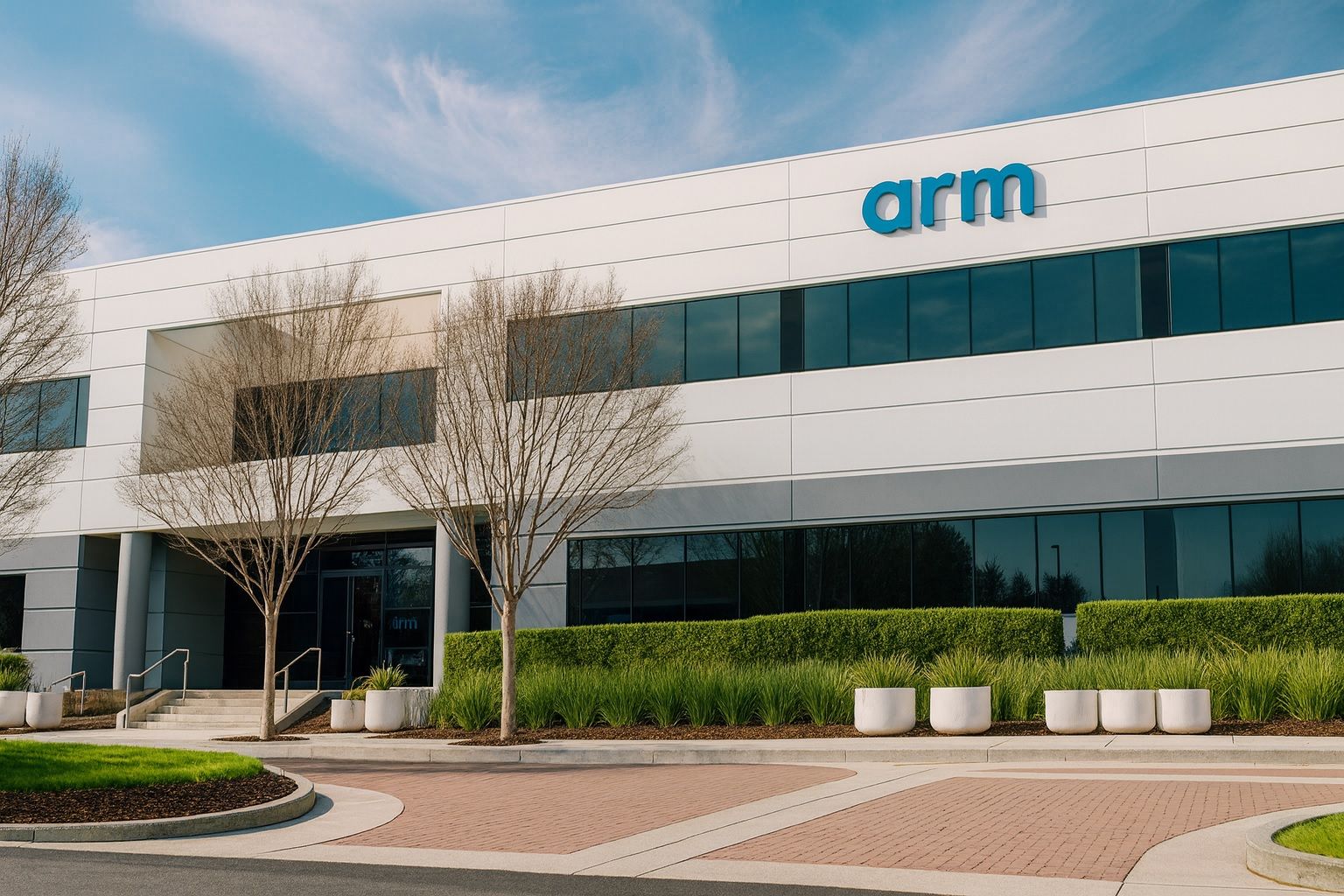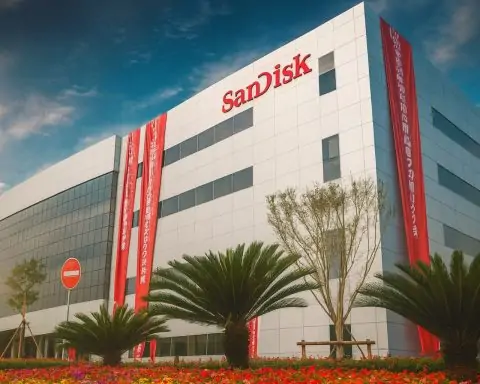Arm Holdings plc (NASDAQ: ARM) trades on the NASDAQ with ticker symbol ARM. As of Oct 14, 2025 its stock is around $171–172, up roughly 11% from the prior close [1] [2]. Monday Oct 13 saw a jump from about $157 to $175 intraday, closing at $171.94 [3] [4]. ARM’s market capitalization is on the order of $164–182 billion, with a trailing P/E of roughly 260× [5]. The 52-week range is about $80–$182.88 [6]. Analysts’ consensus is bullish – roughly 22 of 27 rate it Buy/Strong Buy – with an average 12-month price target near $167–172 [7] [8]. Recent catalysts include major AI and chip-related news: OpenAI is reportedly partnering with SoftBank’s Arm on a new data-center CPU [9], Qualcomm announced it will use Arm’s latest v9 architecture [10], and SoftBank is arranging a large margin loan using Arm shares (tied to its planned OpenAI investments) [11]. This report analyzes ARM’s recent stock moves, financials, industry context, and outlook in detail.
Stock Price & Recent Performance
ARM shares have rallied sharply in the past week. On Oct 13, 2025 (Monday) the stock jumped about 11.07%, rising from $154.81 to $171.94 [12]. Intraday it traded between $157.00 and $175.00 [13]. Over the prior two weeks ARM was up ~23%, reflecting strong momentum [14]. As of market open Oct 14, it remains around $171–172 [15]. By comparison, its 50-day moving average is ~$144 and 200-day ~$136 [16]. The stock trades with high volatility (11% intraday move Oct 13) and a 52-week high near $182.88 [17]. Volume spiked with Monday’s move (around 10–11 million shares) [18], indicating broad investor interest. In pre-market Oct 14 it was slightly higher, reflecting continued enthusiasm (TipRanks noted it was up ~2.6% pre-market) [19]. Overall, ARM has significantly outperformed its peers (e.g. NASDAQ chip indices) in the last two weeks, driven largely by AI-related catalysts.
Recent News & Catalysts
Several major news events in early Oct 2025 helped fuel ARM’s surge. OpenAI Partnership: Reports (originally from The Information and cited by Reuters/Investing.com) indicate OpenAI is collaborating with SoftBank’s Arm on a custom server CPU as part of a broader AI chip strategy [20]. In this plan, OpenAI will design new chips, Broadcom will manufacture AI accelerators, and Arm will provide a general-purpose CPU for data centers [21] [22]. This news (announced Oct 13) directly boosted ARM shares, as investors see Arm playing a key role in the expanding AI data-center market. Qualcomm/Arm v9: On Sept 10 Reuters reported that Qualcomm will use Arm’s new v9 architecture in its next-generation smartphone chips [23]. The day Qualcomm made the announcement, ARM’s stock “jumped ~5%” [24]. Qualcomm’s move confirms Arm’s continuing dominance in mobile/AI chip design, and likely underpins the recent trading excitement. SoftBank Margin Loan: On Oct 10 Reuters reported SoftBank is arranging a $5 billion margin loan backed by its Arm shares [25]. Though SoftBank is borrowing, the loan proceeds will fund more OpenAI investment, signaling SoftBank’s strong commitment to AI (and indirectly to Arm’s upside). This heightened speculation that SoftBank believes in Arm’s growth. Lumex AI Chips: In early Sept, Arm launched “Lumex,” a new AI-optimized mobile chip design platform [26]. Lumex aims to enable advanced on-device AI (e.g. AI model execution without cloud) on smartphones and wearables [27]. This product news reinforces Arm’s role in the AI chipset trend. Broader Market Rally: Monday Oct 13 saw a broad tech rally amid macro cues (e.g. talk of reduced China trade tensions) [28]. Tech-heavy indexes and chip stocks (AMD, NVIDIA, etc.) moved higher, providing a favorable backdrop for ARM’s breakout. In short, multiple positive headlines around AI and chips converged in early October, lifting ARM’s stock.
Financial Performance & Recent Earnings
Arm’s fundamentals remain strong, albeit with some caution. In its Q1 FY2026 (quarter ended June 30, 2025) results, Arm reported record revenue of about $1.05 billion and EPS $0.35, roughly meeting analyst expectations [29]. This was up about 12% year-over-year, making it the second-consecutive quarter above $1B [30] [31]. Royalty revenue (tied to chip shipments by licensees) was especially strong, rising ~25% to $585M [32]. Arm noted broad adoption of its v9/AI designs and its Compute Subsystems in data-center and mobile chips as growth drivers [33]. However, management also warned of potential headwinds: escalating trade tensions could depress smartphone demand, and Arm plans to ramp its own R&D into full chip solutions [34] [35]. On July 31, Arm’s stock plunged 12–13% when it announced it would invest heavily in making its own chips (a shift from pure licensing) and gave conservative Q2 guidance [36] [37]. Analysts currently estimate Arm will earn about $0.90 EPS for FY2026 [38], reflecting strong topline growth partly offset by rising expenses. The company will report Q2 results Nov 5, 2025; for now investors are focused on the implication of AI growth vs. the company’s strategic shift and guidance.
Analysts’ Ratings & Forecasts
Wall Street remains predominantly bullish. As of Oct 2025, 23 analysts cover ARM with a consensus rating of “Strong Buy” [39]. The average 12-month price target is around $167–172, roughly flat to slightly below the current price [40] [41]. Notable recent forecasts include Morgan Stanley (Oct 9) maintaining a $171 target [42] and Evercore ISI (Sep 11) holding a $178 target [43]. These targets imply limited upside (+0–5%) from current levels. Historically, targets have ranged from about $100 to $225 [44]. Overall the consensus “Moderate Buy”/“Strong Buy” rating suggests analysts see the AI growth story as outweighing near-term risks [45]. (MarketBeat.com similarly notes roughly one Strong-Buy, 18 Buys and 7 Holds recently, with a consensus ~$167 target [46].) In sum, experts forecast modest gains; ARM’s stock now trades near the mid-to-high end of analysts’ target range, indicating much optimism is already priced in.
Industry & Competitor Context
Arm sits at the center of the semiconductor/IP ecosystem. Its architectures power ~100% of the world’s smartphones and many servers and IoT devices [47]. The AI hardware boom is boosting demand for Arm-based chips. For example, news of AI data-center expansions sent memory-chip makers Samsung and SK Hynix sharply higher (7–8% gains) when they won major OpenAI contracts [48], reflecting the ripple effects of AI on chip supply chains. Qualcomm’s embrace of Arm’s v9 (for future Snapdragon chips) underscores Arm’s leadership in mobile processors [49]. In data centers, cloud giants are also deploying Arm: Arm estimates ~70,000 enterprises now run Arm-based servers (a 14× increase since 2021) [50], and NVIDIA reports that Google and Microsoft are rolling out Arm-based “Grace Blackwell” AI superchips in their datacenters [51].
That said, Arm faces competition and industry shifts. Major chipmakers like NVIDIA, Apple and Amazon design proprietary silicon (NVIDIA’s GPUs include ARM cores; Apple’s M-series are ARM-based but fully custom; AWS builds its own Graviton Arm CPUs). To some extent, these are also Arm customers. Meanwhile, alternative architectures (e.g. RISC-V in China) and x86 (Intel/AMD) loom as long-term factors. Notably, Intel is even seeking new foundry business – recent reports say Intel may fabricate chips for AMD and AI start-ups [52] – illustrating how all players are scrambling in the AI race. Overall, the industry narrative is overwhelmingly in Arm’s favor: as a leading IP provider, it benefits when smartphone, IoT, automotive and AI-datacenter demand grows. Gartner, for example, projects ~40% annual growth in global AI spending through 2027 [53], which in turn suggests robust demand for Arm’s designs. Major OEMs are also locking in long-term deals: Arm notes that Xiaomi’s new XRING O1 chip uses its platform, Samsung’s latest Flip phone uses an Arm-based Exynos, and “a major smartphone OEM” has signed on for Arm’s next-generation GPUs through 2030 [54]. These wins illustrate Arm’s broad footprint across industries (mobile, automotive, IoT, datacenter).
Risks, Opportunities & Valuation
Opportunities: The AI supercycle is a clear tailwind. Arm’s emphasis on AI-capable architectures (like Lumex and its Scalable Matrix Engine) and Compute Subsystems (CSS) aligns with exploding demand. Its huge developer ecosystem (~22 million developers) and 9 million apps [55] [56]position it to monetize virtually every new AI device. Growth markets like 5G, IoT, automotive AI (Arm’s new Zena automotive platform) and augmented reality all rely on Arm’s IP [57]. SoftBank’s deep pockets and strategic partnership with OpenAI also underscore Arm’s opportunity to contribute to next-gen datacenter chips.
Risks: Valuation is extremely high – ARM’s P/E (~260× trailing, ~91× forward) [58] and Price/Sales (~40×) suggest any hiccup could trigger a sharp correction. In July the stock tumbled when Arm signaled it would spend heavily to build chips, a move seen as risky since it pits Arm against some of its own customers [59]. Trade tensions and a potential slowdown in smartphone or PC markets are further concerns [60]. Geopolitics (e.g. export restrictions, Chinese push for alternatives) or competition from in-house chip efforts by Big Tech could limit Arm’s growth. For example, if major clients like Google or Microsoft increase their own silicon development beyond licensing Arm cores, or if RISC-V gains traction, Arm’s long-term licensing revenue could suffer. Finally, the stock’s momentum is partly speculative (options flows were very bullish on Oct 13 [61]), so any broad tech sell-off could weigh heavily on ARM.
Valuation: ARM’s market cap (~$164B) is now larger than its parent SoftBank’s book value, reflecting sky-high expectations. While analysts generally call it a buy, their price targets suggest only modest upside from here (mid-$170s) [62]. In tech/media commentary, ARM often features among the high-flyers; investors should weigh the AI-driven growth case against the risk of it being “priced to perfection”. For example, Morgan Stanley cautions that building chips could distract from Arm’s core strengths, and notes ARM’s strategy shift might “compete with its own customers” [63]. On the flip side, if ARM continues winning licenses for AI and automotive, and if AI datacenter spending far outpaces current forecasts, the stock could re-rate higher.
Forward Outlook & Forecasts
Looking ahead, most analysts see ARM as a growth story with moderate upside. StockAnalysis reports a “Strong Buy” consensus and an average 1-year target near $167 [64]. That implies returns of only a few percent from today – suggesting many experts believe the current price already factors in much of the near-term upside. However, the high-end forecasts go to $178–$187 [65] [66] (Evercore’s and Morgan Stanley’s targets) and one firm (Seaport Global) even initiated coverage with a $225 Bull-case in August. These targets generally hinge on continued AI growth and new deal wins; if Arm shows signs of accelerating revenue or earnings beyond forecasts, bullish targets could rise further. Some analysts note ARM’s next catalyst will be the Q2 earnings (Nov 5) and any updates on cloud partnerships or licensing momentum. As one commentary put it: “ARM stock surged with AI optimism, but some were ‘disappointed by soft guidance’ in July” [67].
In summary, ARM’s recent 11% rally is tied to very positive AI-chip news and a strong industry backdrop [68] [69]. Investors now face a classic “growth at high valuation” situation: the stock is poised on strong trends but needs continued execution. Analysts’ median view is cautiously bullish (buy but limited near-term upside) [70]. Any shift in the AI boom – whether faster growth or a broader tech correction – could move ARM substantially. For long-term investors, key questions remain whether ARM can keep licensing its IP in new AI domains, and how its shift into chipmaking plays out.
Sources: Author’s analysis based on financial news and reports including Reuters, Investing.com, NASDAQ, Arm press releases, and industry news (October 2025) [71] [72] [73] [74] [75] [76] [77]. These sources provide recent stock prices, earnings data, and expert commentary for Arm Holdings.
References
1. www.reuters.com, 2. stockinvest.us, 3. stockinvest.us, 4. www.reuters.com, 5. www.marketbeat.com, 6. www.marketbeat.com, 7. stockanalysis.com, 8. stockanalysis.com, 9. www.investing.com, 10. ts2.tech, 11. www.reuters.com, 12. stockinvest.us, 13. stockinvest.us, 14. stockinvest.us, 15. www.reuters.com, 16. www.marketbeat.com, 17. www.marketbeat.com, 18. stockinvest.us, 19. www.tipranks.com, 20. www.investing.com, 21. www.tipranks.com, 22. www.investing.com, 23. ts2.tech, 24. ts2.tech, 25. www.reuters.com, 26. www.reuters.com, 27. www.reuters.com, 28. ts2.tech, 29. www.marketbeat.com, 30. www.marketbeat.com, 31. newsroom.arm.com, 32. newsroom.arm.com, 33. newsroom.arm.com, 34. www.reuters.com, 35. www.reuters.com, 36. www.reuters.com, 37. www.reuters.com, 38. www.marketbeat.com, 39. stockanalysis.com, 40. stockanalysis.com, 41. stockanalysis.com, 42. stockanalysis.com, 43. stockanalysis.com, 44. stockanalysis.com, 45. stockanalysis.com, 46. www.marketbeat.com, 47. newsroom.arm.com, 48. ts2.tech, 49. ts2.tech, 50. newsroom.arm.com, 51. newsroom.arm.com, 52. ts2.tech, 53. ts2.tech, 54. newsroom.arm.com, 55. newsroom.arm.com, 56. newsroom.arm.com, 57. newsroom.arm.com, 58. www.marketbeat.com, 59. www.reuters.com, 60. www.reuters.com, 61. www.tipranks.com, 62. stockanalysis.com, 63. www.reuters.com, 64. stockanalysis.com, 65. stockanalysis.com, 66. stockanalysis.com, 67. www.tipranks.com, 68. www.tipranks.com, 69. www.investing.com, 70. stockanalysis.com, 71. www.marketbeat.com, 72. www.investing.com, 73. www.reuters.com, 74. ts2.tech, 75. newsroom.arm.com, 76. www.reuters.com, 77. stockanalysis.com






